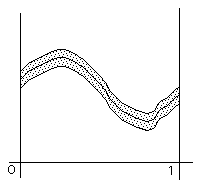Take the sequence of "points" in X (that is, a sequence of sequences) given by:
x1 = (1/1 , 1/2 , 1/3 , ... ), x2 = (1/12 , 1/22 , 1/32 , ... ), x3 = (1/13 , 1/23 , 1/33 , ... ) , ...
Then this sequence of sequences converges to the sequence y = (1 , 0 , 0 , 0 , ... ) in d∞.
Proof
d∞(xn, y) = lub { 0 , 1/2n, 1/3n, ... } = 1/2nand this is small when n is large.

Take the sequence in X given by:
x1 = (1 , 0 , 0 , ... ), x2 = (0 , 1 , 0 , ... ), x3 = (0 , 0 , 1 , 0 , ... ), ...
Then although the "sequence of first components", the "sequence of second components", the "sequence of third components", ... all converge to 0, the sequence xn does not converge to the zero sequence: 0, since d∞(xn, 0) = 1 for all n.
So the theorem proved for finite dimensional spaces in the last section does not hold for this infinite dimensional space.

We claim that this sequence converges to the 0-function in the metric d∞.
Proof
The maximum of the function |fn(x) - 0| is at x = 1 and is 1/n. Thus the real sequence (d∞(fn, 0))→ 0 and so the 0-function is the limit.

Remarks

We can get a "picture" of what convergence in the metric d∞ "Looks like".
Given a function g on (say) [0, 1], we can draw "An ε-band" around its graph.
Then a function is within ε of g provided its graph lies in this ε band.
Thus a sequence (fn)→ g in d∞ if the graphs of every function "far enough down" the sequence lie in an arbitrarily small ε band.
 |f (x) - g(x)|dx. (i.e. the "distance between the functions is the area between their graphs").
|f (x) - g(x)|dx. (i.e. the "distance between the functions is the area between their graphs").
- The picture above shows that the sequence of functions (x/n) converges to the 0-function.

- Here is a curious sequence of "spike functions"
Define fn(x) by:Then (fn)→ the 0-function in the metric d1.
Proof
d1(fn, 0) = the area under the curve = 1/n and so (d1(fn, 0))→ 0 and the sequence converges.

Note however, that this sequence does not converge to the 0-function in d∞ since the graph of fn "sticks out" of any small ε band of the 0-function.Thus it can happen that a sequence which converges in one metric may fail to converge in another.